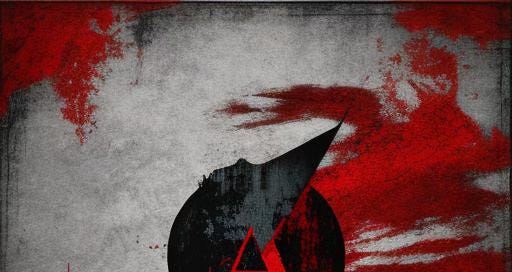Alright, gather round, fellow seekers of truth, rebels of the soul, and wanderers of the cosmic highways. Today, we're delving into the quintessential masterpiece of moral turbulence and societal rebellion: Nathaniel Hawthorne's "The Scarlet Letter." Strap in, because we're about to take a trip through the annals of literature and into the depths of the human spirit.
Picture this: it's the late 1980s, a time of cultural upheaval, where the beat of revolution is dying but still barely pulses through the veins of society. Our protagonist, a "spiritual not religious" hippie punk, roams the streets with a fire in his belly and a thirst for authenticity that burns brighter than the sun. Raised in the tumult of extreme poverty and a failing counterculture, he’s danced to the rhythm of rebellion, questioned the norms, and sought refuge in the realms of the unconventional. That kid was me.
Enter "The Scarlet Letter," a literary bombshell assigned by a high school English teacher that used the symbolism and metaphor of the book to detonate the very foundations of puritanical morality and societal hypocrisy within his classroom. At its heart lies Hester Prynne, a woman branded with the scarlet letter 'A' for adultery, a symbol of her defiance against the suffocating strictures of a judgmental society. Sound familiar? It should, because Hester's journey mirrors the struggles of this intrepid traveler – a soul navigating the turbulent waters of societal expectations and personal freedom. And one who branded himself with a different blood-red letter ‘A’ this one standing for Anarchy.
For your free-spirited protagonist, "The Scarlet Letter" is more than just a novel; it was a roadmap to liberation, a beacon of defiance in a world shrouded in conformity. While generations of kids hated this assigned work, those who paid attention were able to see themselves reflected in Hester's unwavering spirit, her refusal to be bound by the shackles of societal judgment. Like Hester, they wear their 'A' proudly, a badge of honor that signifies their rejection of the status quo and embrace of individuality.
However, "The Scarlet Letter" is more than just a tale of rebellion; it's a meditation on the nature of sin, redemption, and the human condition. Your humble protagonist, who had steeped himself in the ethos of cooperativism and anti-nationalism, found solace in Hawthorne's exploration of these timeless themes. He saw in Hester's struggle a reflection of his own journey towards self-discovery and enlightenment, a quest for meaning in a world fraught with chaos and contradiction.
So much did he embrace the ethos of contradiction that he put himself in the last place anyone would have expected him. He bound himself in duty as a U.S. Marine - scarlet of a different sort, perhaps seeking the same kind of rebirth and finding of redemption as Hester Prynne. Later as your protaganist got lost in the chaos and order of being a fundamentally unruleable being in a totalitarian circus, our traveler crisscrossed the globe, carrying with him the lessons of "The Scarlet Letter," weaving its wisdom into the fabric of his own spiritual quest. From the bustling streets of Bangkok to the serene sands of North Africa, he sought and found echoes of Hawthorne's narrative in the broad-stroked canvas of human experience. And as he penned his own tales of depravity, transcendence, and transformation, he draw inspiration from Hester's unwavering resolve and defiant spirit.
In the end, "The Scarlet Letter" has served as a touchstone for your intrepid protagonist, a reminder of the power of individuality, the sanctity of the human spirit, the power of forgiveness, the glory of redemption and the eternal quest for truth. It's a book that speaks to the rebel in all of us, challenging us to question the norms, defy the conventions, and chart our own course through the wilderness of existence. So, fellow travelers, may you heed the call of Hester Prynne and embrace the scarlet letter of your own defiance and in the fires of rebellion may you find the spark of your own liberation.
In this week’s episode of Web3 Writers - we posed the question, what book fundamentally shaped your view of the world - and I think I surprised some people when I picked this one. There were some other amazing answers and I hope that all who participated (and those who didn’t) might take the time to think about this question and share their conclusions. If you doubt my answer - have a look at the logo of Vagobond Media - and you will likely see the truth reflected there. ~CD
Share your work at https://www.vagobondmagazine.com - we’d love to share it here!





Can definitely see where the inspiration for the logo came from.
This is so powerful! What a journey! And such another reason we are friends. “The scarlet letter was her passport into regions where other women dared not tread.”